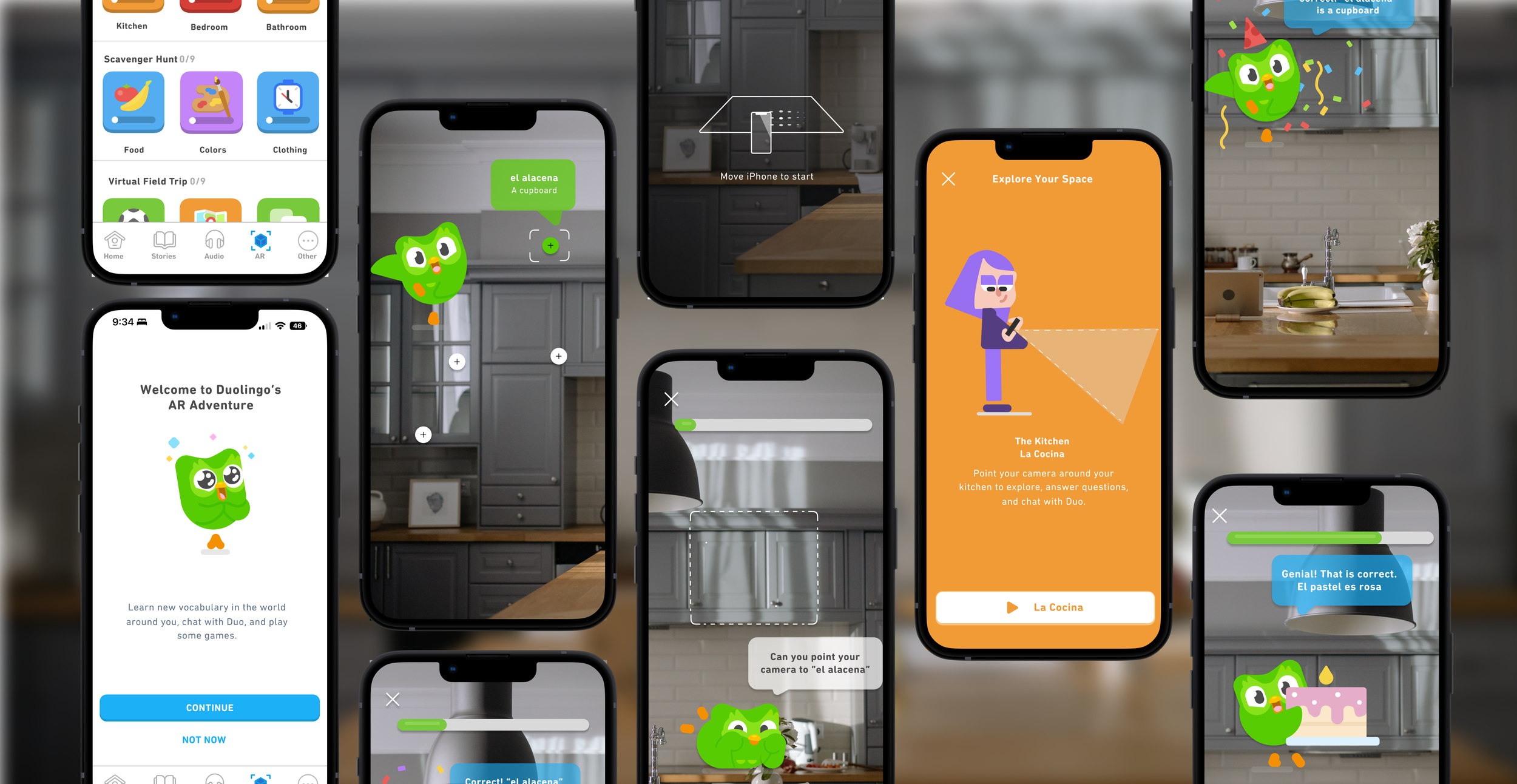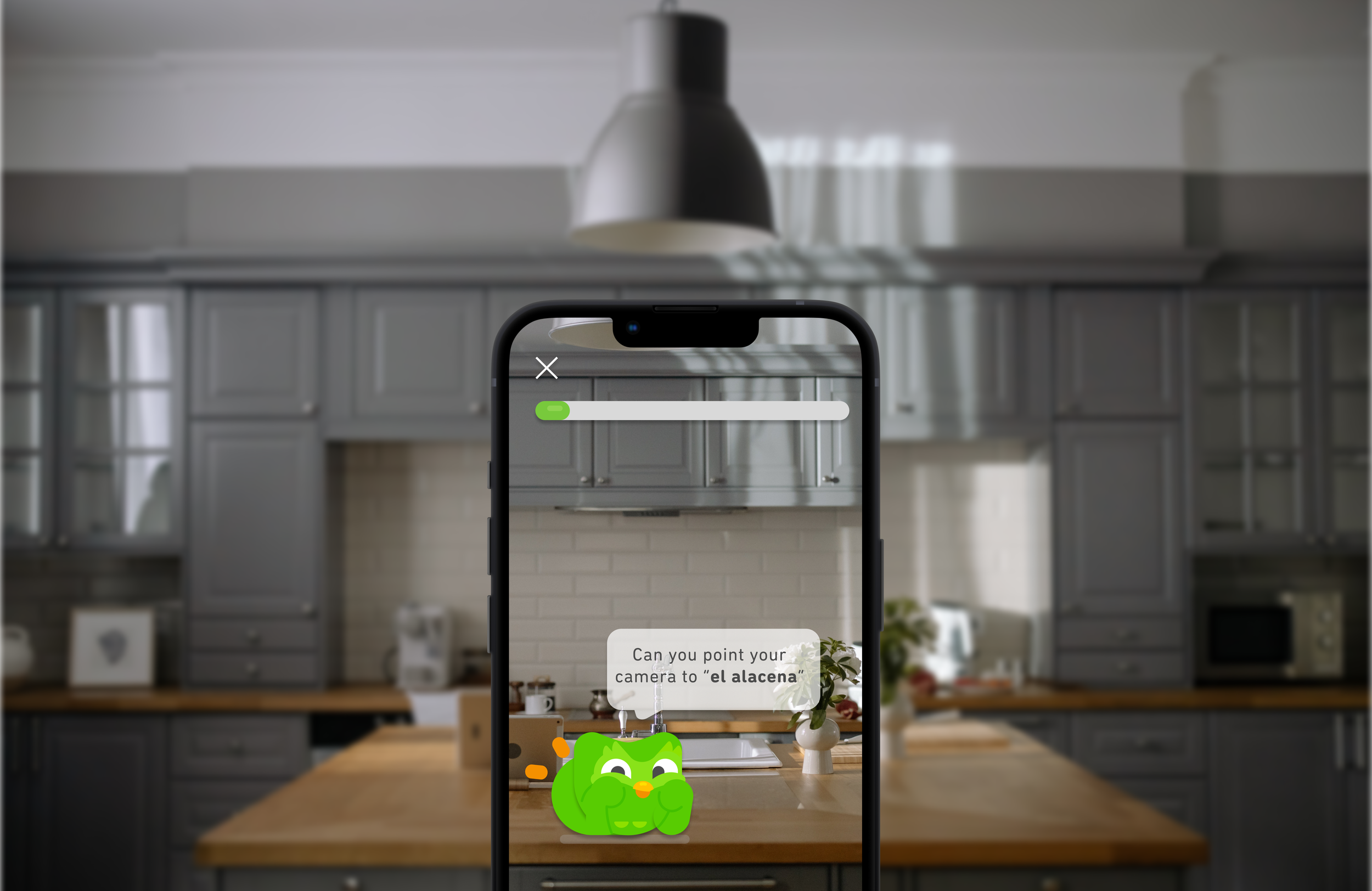
Enhance your language learning journey with Duolingo AR
Timeline
80 hours
My Role
UX Designer
THE PROBLEM
Learning a language is a journey that can be time-intensive, and mentally taxing for users. Let’s make it fun!
Unlock the doors to new opportunities and experiences by breaking free from traditional language learning. For many, the journey to fluency can be frustrating and demotivating. How can we keep language learners motivated and engaged?
According to Duolingo, over 500 million registered users worldwide, but only 0.38% are paid, subscribers. Let's explore the potential of augmented reality (AR) as a solution to increase engagement and motivation and, ultimately, boost daily and monthly subscribers and conversion from free to paid users.
Let's find out with some more research!
THE SOLUTION
Duolingo + AR = A more enjoyable way to learn languages.
I approached this problem with the AR feature in mind as a solution to improve learners' motivation. Let's see how I arrived at this conclusion and show you my process!

WHITE PAPER RESEARCH
AR enhances student learning motivation with interactive content.
My research on the use of AR and VR in language learning has revealed some key findings:
Overall, research shows that AR and VR have the potential to enhance language learning by providing engaging, authentic, and culturally rich experiences.
COMPETITIVE ANALYSIS + THE GAP
Uncovering the competitive edge: How AR is changing the language learning game – Is Duolingo being left behind?
I delved into the world of Duolingo's competitors to see how they stacked up in terms of overall features, user interface, cultural content, and motivation. One surprising discovery was that all of them had an AR feature – except for Duolingo.
This raised the question: Is Duolingo missing out by not offering AR, or is there simply no demand for it among language learners? Time to find out what the users say.
SURVEY
Language learning for the love of it: Personal interest and friends/family motivate over 50% of respondents.
Discover the driving forces behind language learning: I surveyed 14 participants from a language learning forum to find out what motivates them and what tools they use.
The results? 50% were in the 25-34 age range, and most used mobile apps (Duolingo being the most popular) with an interest in an AR feature. Intrinsic motivation was a key factor. These findings suggest that AR could greatly enhance mobile language learning for intrinsically motivated learners.
USER INTERVIEWS
Language learning success: 2x more likely with enjoyment!
I conducted 6 user interviews with self-identified language learners. Target languages included Spanish, German, and Italian. I’ve asked them questions below to find trends on their motivations, frustrations, and wants.
KEY RESEARCH QUESTIONS
What motivates you to learn a new language?
What tools/apps have you used to expand your language skills? How are they helpful?
What techniques do you find most effective when learning a new language?
What has been your biggest challenge in learning a new language?
Do you ever experience a lack of motivation when studying a new language? What is the reason for the lack of motivation.
What frustrations do you have surrounding language learning apps? Language learning in general?
USER INTERVIEWS INSIGHTS
“I don’t use language learning apps much because I feel like they lack context.”
Great news! My initial hypothesis that AR benefits language learners are supported by users.
01
Variety is key. If the process is more varied and exciting, learners are more likely to stick with their learning plan and gain motivation.
02
Games and interactive content are noted as the top must-haves for language learning apps. This is why Duolingo has been so successful in the past
03
Context matters. Interviewees noted that they wished the vocabulary had more context and was more relevant to everyday life.
THE USER PERSONA
Sara's language learning journey: From "Bonjour" to fluency.
Meet Sara, the busy professional who wants to make the most of her upcoming trip to Paris. She's like many of us who took a foreign language in high school but now can only say a few basic phrases. She's determined to change that and is on a mission to master the language in a fun and engaging way.
Join me as I explore the unique challenges and opportunities faced by learners like Sara, and discover how we can design a feature that helps them achieve their goals and maintain motivation throughout their language-learning journey.
THE STORYBOARD IDEATION
How should we bring this feature to life with storyboarding?
I developed a storyboard to illustrate how users interact with the Duolingo AR feature. By creating a storyboard and placing the user in a familiar setting, like a kitchen, I could understand and consider the unique challenges and opportunities of using AR. As a regular Duolingo user, I incorporated key elements from the app's current lesson structure into my design to enhance the user experience. By setting the story in Sara's kitchen and allowing her to communicate with the beloved Duo mascot, I aimed to create a natural, engaging way for users to learn and improve their language skills.
DESIGN CONSIDERATIONS
Immersing users in AR: Unique design considerations to enhance the experience.
AR presents unique challenges for UX and UI because it overlays digital elements upon real-world views. I needed to take specific design considerations when designing the AR 2D elements and overall workflow. At some points, I had to find a balance such as:
THE USER FLOW
Thoughtful new feature onboarding can lead to increased product engagement.
With any new technology, it's crucial to set the stage and onboard the user appropriately to the new feature. That's why I've carefully designed a user flow that ensures a smooth transition into the AR world.
Two key components of the user flow are the new feature announcement and new feature user training. Based on user feedback, I decided to take a module approach for the alert. Users would have the option to click on the modal and move on to the new feature user training, or they could choose to ignore it. The new feature training focuses on those AR considerations previously mentioned.
The goal is to increase subscribers and potential conversion to paid subscriptions by making users aware of the new feature, conveying that Duolingo cares about its users by offering consistent value through updating its products.
THE SKETCHES
Hunt for language mastery with Duolingo's AR ‘Scavenger Hunt’
My preliminary sketches focused on the AR landing pages, but the storyboard was crucial for developing the Hi-Fi wireframes for testing. Let's see if the testers liked the idea of Duolingo AR.
I leveraged Duolingo's existing Stories homepage to make it easy for users to access and categorize the AR lessons. With the Stories layout users know and love and the bonus of four exciting lesson types, users will be well on their way to language mastery in no time.
One of my research insights was variety is key. Let's add variety to the lessons. What kind of lessons can you expect? How about Free Roam, where you can point your phone anywhere and learn new vocabulary? Or try a Scavenger Hunt, where you search for specific items based on prompts. Or you'd prefer a Room/Location lesson, where you learn based on your physical location. And for the ultimate immersive experience, check out Expand Your World, where you can virtually travel to different countries at home. The choice is yours with Duolingo's AR feature
THE DESIGN
User research and feedback led to the following design features…
New Feature Onboarding
AR is a new and exciting way to learn a new language with Duo. The user flow has been carefully designed to ensure a smooth transition into the AR world. The onboarding process guides the user through the environmental conditions required by providing clear instructions and helpful tips to ensure a successful AR lesson.
Surprise Me
Experience language learning in a new way with Duolingo's AR Suprise Me lesson. Use your phone's camera to walk around your environment and learn vocabulary naturally and visually. No more boring flashcards or repetitive drills - just personalized, immersive language learning. Think of it as a free roam with your buddy Duo.
Explore Your Space
Explore your space and learn a new language with Duolingo's AR feature. The guided AR lessons, based on locations around your home, provide an interactive and engaging way to learn. With Duo's help, you'll be able to learn at your own pace without feeling overwhelmed. Try it now and see what you can discover!
PROTOTYPING AND TESTING
Testing the “Explore Your Space” flow was a success!
As I continue developing Duolingo's new AR feature, gathering feedback and insights from real users is essential. That's why I created a simple prototype using Figma and conducted a usability study with 4 individuals who had previous experience using Duolingo. The testers were tasked with completing the Explore Your Space flow, and their feedback helped me test the AR feature's clarity, completion, and comprehension.
One limitation of the prototype was that I did not yet have the Spark AR filter available for testing, so the testers had to walk through the Figma interaction rather than experience it in real-time. In future iterations, I will include the Spark AR filter or Unity to give users a more accurate sense of the AR experience.
Overall, the usability study was a success and gave me valuable insights to help improve the AR feature.
USER TESTING INSIGHTS
01
Testers liked the onboarding process but wanted a test question to ensure they were using it correctly and that it didn’t impact their lesson score.
02
Testers mentioned they were interested in the ‘Surprise Me’ and ‘Expand Your World’ flow
03
The testers shared the AR feature design fits the Duolingo design aesthetic and would be a feature that they would use regularly.
Check out the final design!
FINAL DESIGN
AR proves to be an effective language learning experience by adding fun to the learning journey.
CONCLUSION + LESSONS LEARNED
01
My initial goals were to create an AR filter via SparkAR or Unity. Due to time constraints, I could not complete the filter with those programs. I spent my time on research, thoughtfully making the user flow and the 2D UI elements. My future goal is to upskill in AR development and create the filter.
02
I approached this design challenge with a solution in mind. I needed to ensure that the users I interviewed and surveyed had a need for AR and supported my hypothesis.
03
I enjoyed learning about AR and all the potential tools and possibilities. With that being said, it started to become overwhelming because I wanted to learn and create everything around AR.
THE FUTURE
Duolingo AR, The Sequel
This project is ongoing, and I had many ambitions for the final product, but I focused on more research and 2D elements. In a future iteration, I would create an AR filter in SparkAR or Unity and incorporate a branding aspect, such as a partnership with IKEA to show different types of furniture in your space while also learning vocabulary.









